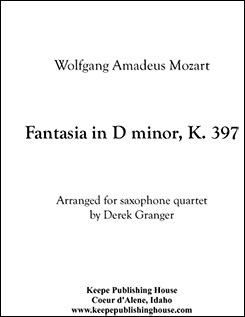
Dedicated to promoting and preserving the very best of classical and contemporary saxophone literature
Bulletin Board
Call for Compositions!
KPH is wanting to promote and publish mixed ensemble music with saxophone. In particular, saxophone, cello, piano trio. This is an under-explored instrumentation which is growing in popularity. Please see our Submissions page for more information.

![]()

This month we feature Derek Granger's brilliant arrangement of
Mozart's popular Fantasia in D minor, K. 397,
originally written for keyboard.
Granger, Derek - Fantasia in D minor, K. 397 (ca. 1782) arrangement for saxophone quartet Program Notes: Fantasia in D minor, K. 397 is one of Mozart’s most widely played works for solo keyboard. Despite its popularity, the work is shrouded in mystery. Its exact date of composition is unknown, though most scholars agree that Mozart likely wrote it in early 1782, one year after he moved to Vienna. It was there that Mozart came to admire the masterful counterpoint of J. S. Bach (as well as the emotionally charged, improvisatory keyboard fantasies of C. P. E. Bach) and to absorb the language of the Baroque to the point that he adopted into his own music.
Fantasia in D minor is in three broad and contrasting sections. An introduction of somber arpeggios finishes on the dominant harmony (m. 11), building expectation for the adagio section to follow, which comprises the bulk of the piece. The first theme (m. 12) is poignantly tragic in character, filled with sighing two-note slurs. The striking second theme (m. 20), heralded by repeated notes atop sinking chromatic chords, is like a funerary tolling of bells. Three ensuing presto cadenzas punctuate returns of this melodic material. The final allegretto, set in D major, lifts us from brooding. While its mood does not quite reach full Mozartian joy, its cheerful affect retains a glimmer of the poignance of the first adagio. It is important to note that the final ten measures were composed not by Mozart but by August Eberhard Müller, a musical admirer of his. Why Mozart left the work on a chord that sounds so unfinished (m. 100) may never be known. This arrangement for saxophone quartet bears musical opportunities and challenges. The lyricism and varied colors of the saxophone quartet offer expressive elements that a keyboard cannot achieve. The original key of D minor has been preserved, for reasons mentioned previously. The range of the work fits the modern saxophone quartet well, with the exception of bass notes in m. 11 and at the end of the second presto, which have been notated up one octave in the baritone. A primary challenge will be linking the running notes in each cadenza, without gap or dissonance, between each voice of the quartet. The distribution of notes by instrument reflects musical patterns, and highlights registers of the saxophone that blend most readily. It will be important for each member to know each other part well in order to confidently execute smooth transitions. Articulation and expressive markings were largely left in Mozart’s time to performers (who themselves would have been well enough versed in contemporary practices not to need them). I have added markings in this edition to aid in contemporary performance and mitigate some of the differences between piano and saxophone. Any quartet seeking to perform this work should consult numerous quality recordings in developing their own interpretation, a practice that may very well result in the alteration of some of the printed markings. No matter how the piece is ultimately interpreted, it is important to weave the contrasting sections into a coherent musical whole, one that uses silences with as much purpose as the notes themselves. Final considerations of vibrato usage, timbre, and the like are left to the taste of the performers. |
 |
Order your digital copy today. Find more of our Saxophone Quartet offerings (here) as well.






